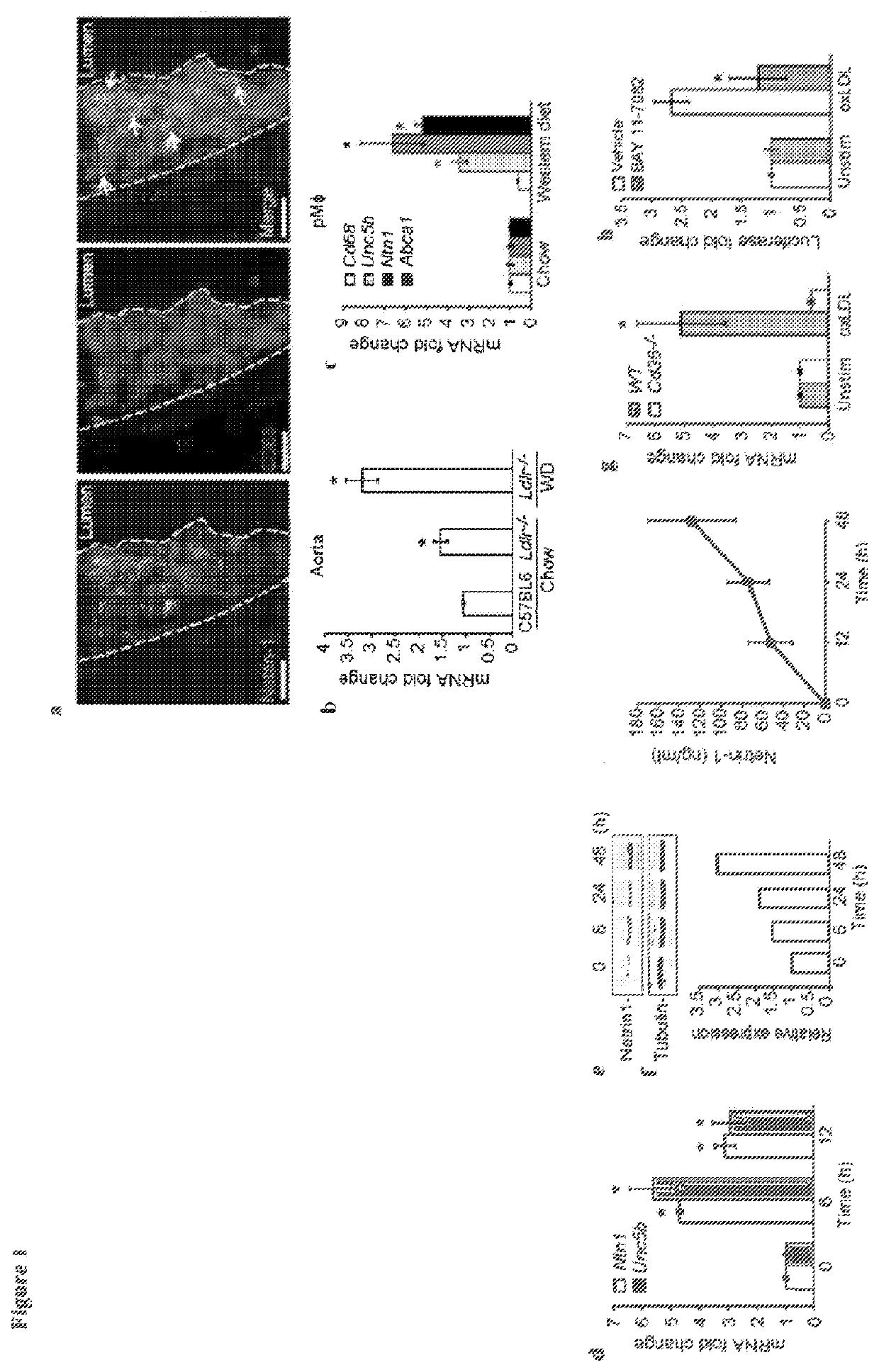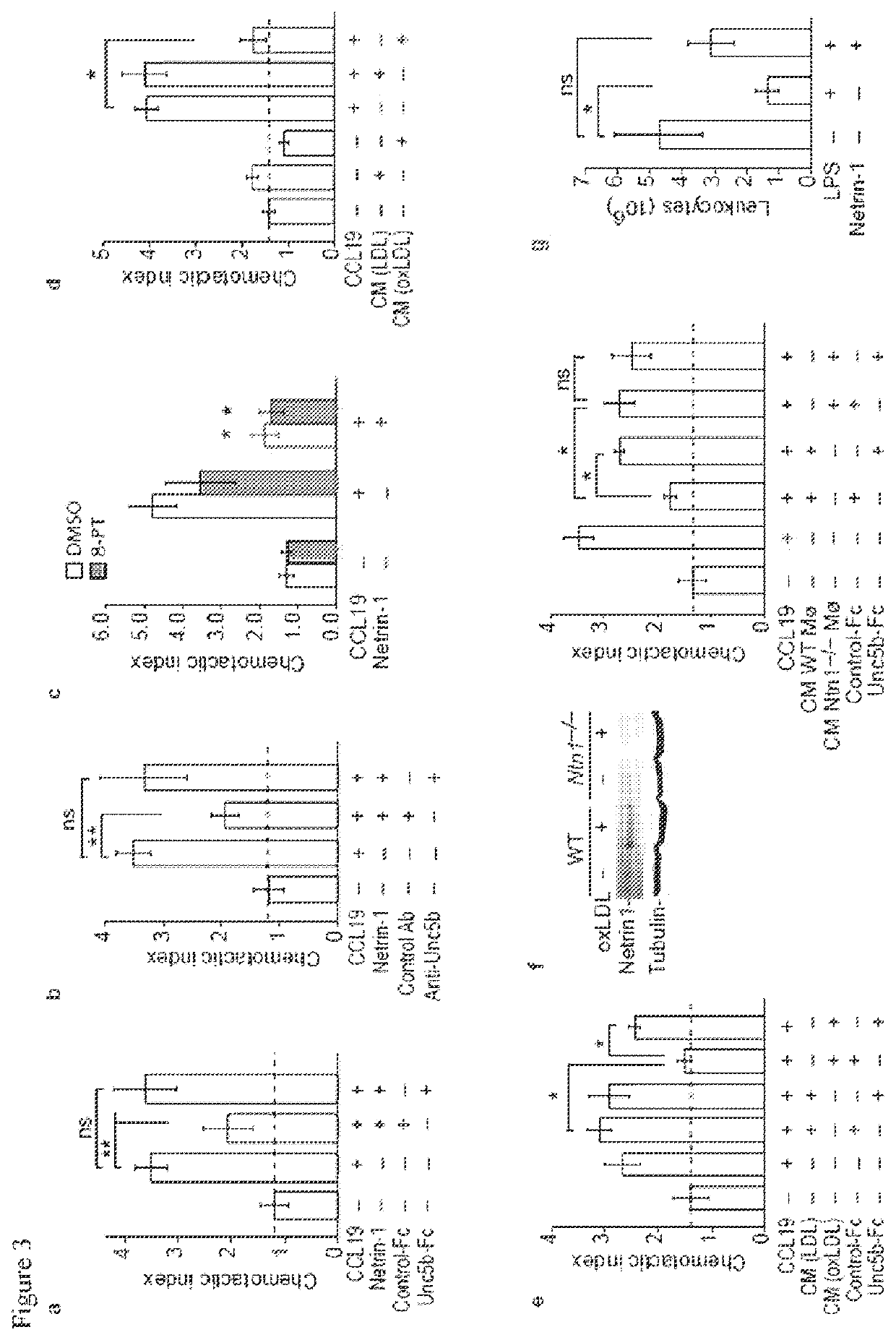Methods for treating inflammation
a technology of inflammation and composition, applied in the direction of drug composition, peptide/protein ingredient, peptide, etc., can solve the problems of nonlinear process of axon guidance, attractive or repulsive, limited in the central nervous system,
- Summary
- Abstract
- Description
- Claims
- Application Information
AI Technical Summary
Benefits of technology
Problems solved by technology
Method used
Image
Examples
example 1
Background
[0153]Given its role in inhibiting leukocyte migration, it is desirable to determine whether netrin-1 contributes to the retention of macrophages in the chronic inflammatory milieu of the atherosclerotic plaque. The present data shows that netrin-1 is abundantly expressed by macrophage foam cells formed in vitro and in vivo, and in human atherosclerotic lesions. In functional studies netrin-1 expressed by foam cells differentially regulates cellular constituents of atheroma: netrin-1 inactivates macrophage migration and supports chemoattraction of coronary artery smooth muscle cells. Thus, expression of netrin-1 in plaques likely simultaneously prevents inflammatory cell egress, and induces smooth muscle cell recruitment into the intima, thereby promoting lesion progression. In support of this, deletion of netrin-1 in myeloid cells dramatically reduces atherosclerosis lesion size and complexity in Ldlr− / − mice, and is associated with macrophage emigration from plaques.
Mate...
example 2
Materials and Methods
Reagents
[0187]OxLDL was prepared as described by first dializing LDL (0.25 mg / ml) in PBS for 24 hours at 4° C. and then incubating with 5bμM CuSO4 for 6 hours at 37° C. (Kunjathoor et al., J Biol Chem. 2002; 277:49982-49988). To stop the reaction, 0.25bmM EDTA and 50 μM BHT were added. Cobalt chloride (CoCl2) and dimethyloxalylglycine (DMOG) were from Sigma Aldrich (15862; D3695). The NFκB inhibitor Bay11-7082 and HIF-1α inhibitor (400083) were from Calbiochem.
Cell Culture
[0188]Primary bone marrow derived macrophage (BMDM) were prepared by flushing the bone marrow of the tibia and femur of 6-8 week old C57 / B6 mice as described (The cells were grown in DMEM supplemented with 15% L929-conditioned media, 10% FBS and 1% penicillin / streptomycin for 7 days and then treated with oxLDL or subjected to hypoxic conditions. Hypoxic incubations were carried out at 37° C. in a Billups-Rothenberg modular incubator chamber at 1% O2, 5% CO2 and 94% N2 for 24 hours. J774 control...
example 3
Methods
Experimental Animals and Diet
[0209]C57BL / 6J, Ldlr− / − and Apoe− / − mice were from Charles River or Jackson Laboratories. All mice were maintained in a pathogen-free facility. Experimental procedures were performed in accordance with the New York University School of Medicine's Subcommittees on Research Animal Care and Use. All experiments were approved by the New York University School of Medicine Institutional Animal Care and Use Committee. Aortic arch transplantation studies were conducted as previously described (Chereshnev, et al., J Surg Res., 2003, 111:171-176). Briefly, Apoe− / − mice were weaned at 4 weeks and placed on a Western diet (WD; 21% [wt / wt] fat, 0.3% cholesterol; Research Dyets) for 16 weeks. The mice were then divided into three groups 0) a pre-transplant group (n=5) for baseline analysis (ii) aortic transplants into Apoe− / − recipient mice (n=5) (iii) aortic transplants into wild type (C57 / BL / 6) recipient mice (n=5). Recipient mice were 20 week old males kept ...
PUM
| Property | Measurement | Unit |
|---|---|---|
| molecular weight | aaaaa | aaaaa |
| concentrations | aaaaa | aaaaa |
| concentrations | aaaaa | aaaaa |
Abstract
Description
Claims
Application Information
 Login to View More
Login to View More - R&D
- Intellectual Property
- Life Sciences
- Materials
- Tech Scout
- Unparalleled Data Quality
- Higher Quality Content
- 60% Fewer Hallucinations
Browse by: Latest US Patents, China's latest patents, Technical Efficacy Thesaurus, Application Domain, Technology Topic, Popular Technical Reports.
© 2025 PatSnap. All rights reserved.Legal|Privacy policy|Modern Slavery Act Transparency Statement|Sitemap|About US| Contact US: help@patsnap.com



